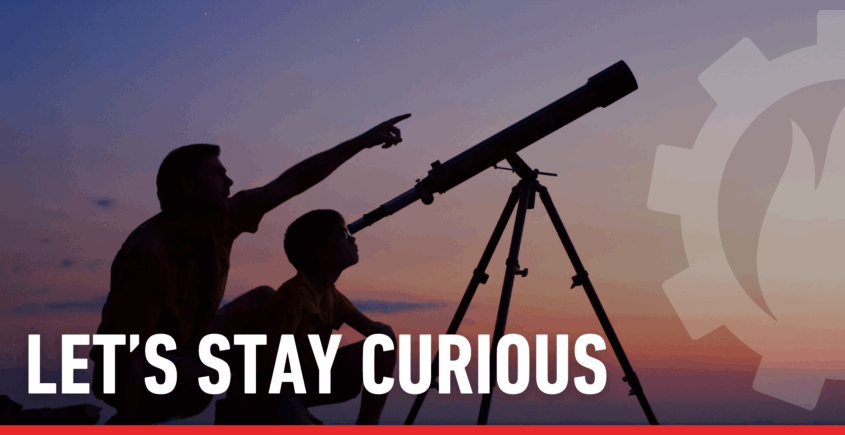Let’s Stay Curious
Curiosity is a great word. For me (and for the gang here at KHT), it’s our never-ending pursuit of wonder, knowledge, exploring, testing, and problem-solving. There are so many people throughout history who were driven by curiosity, from the mundane to the amazing discoverers. I love reading about remarkable adventures – those who “headed West” with a wagon and bunch of horses, or the folks grinding away in the lab. Over the past few weeks, I’ve really enjoyed some clear skies at night, causing me to “look up” and ponder the stars – it’s fun to find the satellites circling the earth. Today, August 8th, marks a historic achievement in the amazing discovery life of Galileo Galilei, known as just Galileo (think Tiger, Oprah, and Lebron, Michelangelo). When Galileo Galilei pointed his rudimentary telescope at the night sky on this day in 1609, there is no way he could have imagined that centuries later, humanity would be observing the universe from spacecraft and mountaintops with instruments so powerful they can see galaxies billions of light-years away. Here’s a little history about Galileo, along with a list of milestone astronomy achievements, as gradual technology improvements and good old “know-how” bring us to today’s far-seeing telescopes. (Be sure to watch the YouTube video below on the newest billion-dollar telescope in Chile – it’s truly amazing!!) The “know-how” and engineering that went into it is mind-boggling. Enjoy! And, feel free to dig deeper on each one with the links – amazing!!)

Galileo: The Father of Modern Astronomy – Born: February 15, 1564, Pisa, Italy. He grew up in a musical family, studied medicine at the University of Pisa, and then shifted to mathematics and natural philosophy. In 1609, he improved the design of the telescope (though he didn’t invent it) and went on to discover the four largest moons of Jupiter (Io, Europa, Ganymede, Callisto) in 1610 – known today as the Galilean moons. He observed phases of Venus, providing evidence that Venus orbits the sun, and studied sunspots and the rough, mountainous surface of the Moon and countless stars in the Milky Way. He championed the heliocentric model (Sun-centered solar system) supported by Copernicus, which challenged Church doctrine at the time. Tried by the Roman Inquisition, he spent the last years of his life under house arrest – and is considered a founder of modern physics and observational astronomy.
1668 – Newton’s Reflector: Solving the Color Problem – Early refractors suffered from chromatic aberration, where colors wouldn’t focus correctly. To solve this, Isaac Newton developed the first practical reflecting telescope, using mirrors instead of lenses – primarily a concave primary mirror to gather light and a flat diagonal mirror to direct it to an eyepiece – a solution that was compact, cheaper, and clearer than refractors of the time. (note: All major modern optical telescopes—including Hubble and Webb—are based on Newton’s mirror concept!)
1789 – Herschel’s 40-Foot Telescope: Building Bigger – William Herschel, already famous for discovering Uranus, built the largest telescope of his time – a 40-foot-long reflector with a 49.5-inch metal mirror. Constructed from polished speculum metal (an alloy of tin and copper), it required a crane to maneuver due to its size and weight, and took 20 years to complete. Herschel was able to map thousands of nebulae and star clusters and supported Herschel’s hypothesis that the Milky Way was a disk-shaped galaxy.
1845 – Leviathan of Parsonstown: Spiral Galaxis Appear – The 3rd Earl of Rosse, William Parsons, built the Leviathan of Parsonstown in Ireland with a 72-inch (6-foot) mirror. Mounted between two massive stone walls for stability, he used speculum metal mirrors, which tarnished quickly. For 72 years, it remained the world’s largest telescope. It was the first to clearly observe and sketch spiral structure in galaxies like M51 (Whirlpool Galaxy) and opened the door to understanding galaxies as vast, structured systems—not just fuzzy patches of light. His telescope changed our understanding of “nebulae”, paving the way for identifying galaxies as distant star systems.
1917 – Hooker Telescope (Mount Wilson): The Expanding Universe – Perched high in California’s San Gabriel Mountains, the 100-inch Hooker Telescope was the first large reflector with modern engineering—metal tubing, precision motors, and tracking systems, helping astronomers move from a Milky Way-centered view of the universe to understanding that the cosmos is vast and growing. Edwin Hubble ( a now famous name) used it in the 1920s to prove that the Andromeda “nebula” was a separate galaxy and discovered redshift in galaxies, leading to the conclusion that the universe is expanding.
1948 – Hale Telescope (Palomar): Named after George Ellery Hale, the 200-inch (5.1-meter) Hale Telescope was the largest operational optical telescope for over four decades. It used a Pyrex mirror to reduce thermal distortion, with a complex equatorial mount allowed precise tracking of stars. With all that was going on in Europe, it was built during WWII; the first light came in 1948. Its long-term scientific contributions include quasars and active galactic nuclei, precise classification of galaxies, and the structure of galaxy clusters, making it the model for future observatories.
1990 – Hubble Space Telescope: Clear Eyes in the Sky: Launched aboard the Space Shuttle Discovery (how cool is that!!!), the Hubble Space Telescope orbits above Earth’s atmosphere, capturing crystal-clear images across UV, visible, and near-infrared light. Initially, a mirror flaw caused blurry images but was fixed in 1993 by astronauts in space. Hubble measured the age of the universe (about 13.8 billion years), captured the Hubble Deep Field, revealing thousands of ancient galaxies in a tiny sky patch, and observed black holes, dark energy effects, and stellar evolution. With the internet and good marketing, Hubble brought space to the public eye with its stunning, high-definition images.
2009 – Kepler Space Telescope: The Exoplanet Revolution: Kepler was a specialized space telescope with one mission: to find Earth-like planets. It used transit photometry to detect dips in star brightness caused by orbiting planets, staring at 150,000 stars continuously, identifying over 2,600 confirmed exoplanets and found systems with multiple planets and Earth-sized worlds in habitable zones. Kepler proved that planets are everywhere, making the search for life more hopeful than ever.
2013 – ALMA (Chile): Seeing the Invisible Universe: The Atacama Large Millimeter/submillimeter Array sits high in Chile’s Atacama Desert. It uses radio waves, especially millimeter wavelengths, to observe the coldest and most distant parts of the universe. It can see through dust clouds that block visible light and is perfect for studying protoplanetary disks, early star formation, and cosmic microwave background radiation. ALMA helps reveal the structure and chemistry of the early universe with unmatched clarity.
2016 – FAST (China): Giant Ear to the Universe: China’s Five-hundred-meter Aperture Spherical Telescope (FAST) is the world’s largest filled-aperture radio dish. It is 500 meters in diameter, actually built into a natural depression in Guizhou province. Its goal is to detect pulsars, fast radio bursts, and potential alien signals and map hydrogen in galaxies to study structure and evolution. Fun Fact: FAST can detect a signal as faint as a cell phone call from the Moon (can you hear me now??).
2021 – James Webb Space Telescope (JWST): A Time Machine: After years of delays, the JWST launched on Christmas Day 2021 and settled at the Lagrange Point L2, 1.5 million km from Earth. Its revolutionary design includes 18 gold-plated mirror segments, 6.5 meters across, with a Giant sunshield to keep the telescope cold. It can be observed in infrared, ideal for viewing ancient, redshifted light. Early Breakthroughs include the first direct spectra of exoplanet atmospheres and observing galaxies just 300 million years after the Big Bang, redefining everything we know about the early universe, galaxy formation, and alien worlds.
2025 – Vera C. Rubin Observatory (Chile) The Next Generation of Super Telescopes: The Vera C. Rubin recently opened, is equipped with the largest digital camera ever built (3.2 gigapixels). It’s also known as the Extremely Large Telescope, designed to map the entire sky every few nights. Its key mission: to understand dark matter, dark energy, and detect asteroids. It contains a 39-meter mirror (the largest in the world) to directly image Earth-like exoplanets and analyze their atmospheres. It will map the skies with millions of images over a 10-year period, uncovering universe info beyond our imagination.
Other projects in the works: Giant Magellan Telescope (GMT) will use seven 8.4-meter mirrors to create a single 24.5-meter aperture with precision adaptive optics for ultra-clear imaging (think 200 times more powerful than what we have today! And the Thirty Meter Telescope (TMT), an international project planned for Hawaii (pending site resolution), to explore early galaxies, black holes, and cosmic inflation.
If Galileo were alive today, he might be amazed at what his “spyglass” has become. But more importantly, he would recognize the same spark of curiosity and courage that drove him to look up, question everything, and change the world.
How did you do on last week’s logo contest?
Check out our logo guide for the “Measure Up” post here!






Leave a Reply
Want to join the discussion?Feel free to contribute!